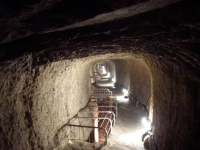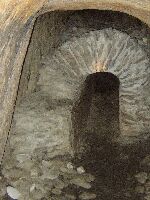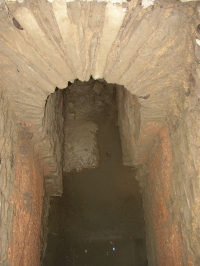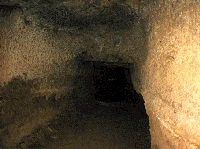



Tunnels
Approximately 80% of the total length of Rome's aqueducts ran subterranean. The preference for underground structures persisted long after they were called for by the threat of invasion. This was due to several advantages they had over surface structures. Firstly, they were more economical, as they required less material to build than archways. Secondly, they were not subject to wind stress or erosion that weakened the surface structures. Thirdly, the periodic earthquakes on the Campagna damaged the underground structures less than the surface structures, and were also cheaper to repair when they were damaged. Finally, underground structures were less disruptive of surface activities (Aicher, 1995:11).The sizes of the tunnels varied, sometimes within the same aqueduct. Typically they were about one metre wide and two metres tall, allowing room for the tunnellers and maintenance men to work. At frequent intervals the tunnels were connected to the surface with a vertical shaft named a puteus or lumen. The distance between these shafts varied between 30 and 60 metres. These shafts were equipped with handholds and footholds. They performed several functions. During the initial construction of the tunnel they allowed work to proceed at several points and not just at the two faces at opposite ends of the tunnel. They were also useful in determining the depth of the tunnel below the surface, by dropping a plumb line down the shaft. This would also serve to determine and manage the slope of the tunnel. When the aqueduct was in use, the shafts provided for air circulation and for maintenance access. Tunnels under deeper mountains, such as the Barberini tunnel under Mt. Arcese, dispensed with these shafts. Originally the tops of the shafts were covered with lids of stone or wood (Aicher, 1995:12).
The usual method of tunnel construction, as recommended by Vitruvius, was to make the tunnel more or less straight with vertical shafts at intervals of about 35.5 metres. It is easy to ensure that a shaft is exactly vertical by hanging a plumb-bob line from a rod across the top, and ensuring that the bob hands in the centre of the shaft all the way down. A line of posts was laid over a hill, using optical sighting, and shafts sunk from them. This makes the horizontal alignment of the tunnel easier. One the tunnel reaches the first shaft it can be aligned by sighting rods under the centre of each shaft, and will more or less reliably meet up with the next along a straight line. There is evidence to suggest that the Romans sometimes did not trouble to get the gradient exactly right at the initial stage, but corrected it later by making a channel in the floor of the tunnel, which could be adjusted a little up or down as required (Landels, 2000:39).
When digging a tunnel from both sides of a hill or mountain, there is always the possibility of the two ends not meeting. The error can be planimetric or altmetric. The altimetric is the more serious of the two possible errors, and could mean that one half of the tunnel was simply not usable. The best case altimetric error results in a small waterfall in the tunnel. If the water were to flow the other way, the result may be the formation of a dam. Planimetric errors are more acceptable. These can usually be corrected by connecting the two halves of the tunnels by digging at an angle from one end until the two are joined (Taylor, 2007:75).
The longest tunnel used in the area of Rome was probably used in the Anio Novus. It was about 2.25 kilometres long. No trace of it survives, but its existence is attested by the presence of otherwise impenetrable hills that cross the line of the aqueduct. Shorter tunnels between 50 and 400 metres were not uncommon. If possible, tunnels were made by sinking a number of vertical shafts and tunnelling in both directions from the bottom of each. Once the channel or tunnel is made, the shafts provided ventilation and easy access for inspection and maintenance. An experienced miner could spot the points at which subsidence or collapse might be expected and promptly stop the leak (Landels). The shafts might also serve to release air pressure that might form when the inflow of water increased sharply. The openings were usually round, sometimes square. It is not known whether the Romans were influenced by the one great advantage of a round manhole cover over a square one, it is impossible to drop the lid through the hole (Hodge, 2002). Occasionally the ridge or hill that needed tunnelling was too high, making vertical shafts impractical. The tunnel was there driven in one continuous bore, either starting at one side and continuing until the tunnel was complete, or starting at both ends and meeting in the middle. The latter was probably the normal method, as it cut the working time by as much as half. This method faces the problem of orientation, and indeed there are examples of "misses", such as in Saldae in North Africa. An inscription by Nonius Datus, an army engineer, complains how the two halves of the tunnel missed each other by so much and the workers continued digging for so long that they almost had two tunnels (Hodge, 2002).
From the thesis of Evan J. Dembskey on The aqueducts of Ancient Rome